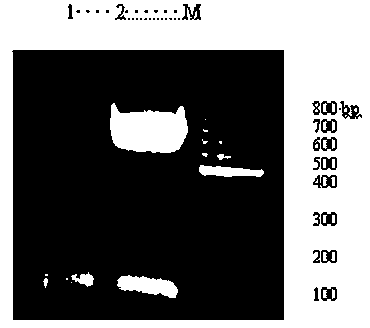Method for constructing transgenic Nosema bombycis
A microsporidia and transgenic technology, applied in the field of genetic engineering, can solve the problem of lack of a research platform for the gene function of microsporidia, etc.
- Summary
- Abstract
- Description
- Claims
- Application Information
AI Technical Summary
Problems solved by technology
Method used
Image
Examples
Embodiment 1
[0032] Embodiment 1: Based on pIZT / V5-His-mediated transgene of Bombyx mori Microsporidia
[0033] (1) with 10 6 / mL of silkworm microspores smeared with mulberry leaves and fed silkworms from the 4th instar for 6 hours, and fed for 3 to 4 days.
[0034] (2) Mix 5 μL of 2 μg / μL pIZT / V5-His (Invitrogen) with 5 μL of liposomes, inject the silkworms in step (1) into the body cavity, and continue to raise them.
[0035] (3) After 2 to 4 days, silkworm hemolymph was collected and observed with a fluorescence microscope. It was observed that some blood cells showed green fluorescence ( figure 1 ), adding silkworm hemolymph to silkworm BmN cultured cells, cultured at 26°C, and observed fluorescence every day.
[0036] (4) Aspirate half of the old culture medium every 2-3 days, add corresponding fresh medium and normal silkworm BmN cultured cells, and culture at 26°C.
[0037] (5) Observing the cultured cells with a fluorescence microscope, when the microsporidia infecting the cult...
Embodiment 2
[0043] Example 2: Transgenesis of Microsporidia silkworm mediated by piggyBac transposon vector pigA3GFP
[0044] (1) with 10 6 / mL of silkworm microspores smeared with mulberry leaves and fed silkworms from the 4th instar for 6 hours, and fed for 3 to 4 days.
[0045](2) Take 2.5 μL of 4 μg / μL pigA3GFP and 2.5 μL of 4 μg / μL helper plasmid (see Tamura Toshiki. et al. Germline transformation of the silkworm Bombyx mori L. using a piggyBac transposon-derived vector. Nature Biotechnology, 2000, 18:81-84)) was mixed with 5 μL of liposomes, injected into the silkworm in step (1) into the body cavity, and continued to be reared.
[0046] (3) After 2 to 4 days, take silkworm hemolymph and observe it with a fluorescent microscope. Some blood cells were observed to show green fluorescence. Take silkworm hemolymph and add it to silkworm BmN cultured cells, culture at 26°C, and perform fluorescence observation every day.
[0047] (4) Aspirate half of the old culture medium every 2-3 da...
PUM
 Login to View More
Login to View More Abstract
Description
Claims
Application Information
 Login to View More
Login to View More - R&D
- Intellectual Property
- Life Sciences
- Materials
- Tech Scout
- Unparalleled Data Quality
- Higher Quality Content
- 60% Fewer Hallucinations
Browse by: Latest US Patents, China's latest patents, Technical Efficacy Thesaurus, Application Domain, Technology Topic, Popular Technical Reports.
© 2025 PatSnap. All rights reserved.Legal|Privacy policy|Modern Slavery Act Transparency Statement|Sitemap|About US| Contact US: help@patsnap.com



